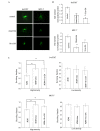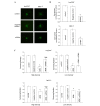Influence of gap junction intercellular communication composed of connexin 43 on the antineoplastic effect of adriamycin in breast cancer cells
- PMID: 28356970
- PMCID: PMC5351289
- DOI: 10.3892/ol.2016.5471
Influence of gap junction intercellular communication composed of connexin 43 on the antineoplastic effect of adriamycin in breast cancer cells
Abstract
Gap junctions (GJs) serve the principal role in the antineoplastic (cytotoxicity and induced apoptosis) effect of chemical drugs. The aim of the present study was to determine the effect of GJ intercellular communication (GJIC) composed of connexin 43 (Cx43) on adriamycin cytotoxicity in breast cancer cells. Four cell lines (Hs578T, MCF-7, MDA-MB-231 and SK-BR-3) with different degree of malignancy were used in the study. The results of western blotting and immunofluorescence revealed that, in Hs578T and MCF-7 cells, which have a low degree of malignancy, the expression levels of Cx43 and GJIC were higher than those in MDA-MB-231 and SK-BR-3 cells (which have a high degree of malignancy). In Hs578T and MCF-7 cells, where GJ could be formed, the function of GJ was modulated by a pharmacological potentiators [retinoid acid (RA)]/inhibitors [oleamide and 18-α-glycyrrhetinic acid (18-α-GA)] and small interfering RNA (siRNA). In high-density cells (where GJ was formed), enhancement of GJ function by RA increased the cytotoxicity of adriamycin, while inhibition of GJ function by oleamide/18-α-GA and siRNA decreased the cytotoxicity caused by adriamycin. Notably, the modulation of GJ did not affect the survival of cells treated with adriamycin when cells were in low density (no GJ was formed). The present study illustrated the association between GJIC and the antitumor effect of adriamycin in breast cancer cells. The cytotoxicity of adriamycin on breast cancer cells was increased when the function of gap junctions was enhanced.
Keywords: adriamycin; breast cancer; connexin 43; gap junction.
Figures





Similar articles
-
[Effect of gap junction modulation on antitumor effects of adriamycin in estrogen receptor-positive breast cancer cells].Nan Fang Yi Ke Da Xue Xue Bao. 2018 Jul 30;38(7):780-786. doi: 10.3969/j.issn.1673-4254.2018.07.02. Nan Fang Yi Ke Da Xue Xue Bao. 2018. PMID: 33168517 Free PMC article. Chinese.
-
Tumor-induced loss of mural Connexin 43 gap junction activity promotes endothelial proliferation.BMC Cancer. 2015 May 23;15:427. doi: 10.1186/s12885-015-1420-9. BMC Cancer. 2015. PMID: 26002762 Free PMC article.
-
Context dependent reversion of tumor phenotype by connexin-43 expression in MDA-MB231 cells and MCF-7 cells: role of β-catenin/connexin43 association.Exp Cell Res. 2013 Dec 10;319(20):3065-80. doi: 10.1016/j.yexcr.2013.10.002. Epub 2013 Oct 10. Exp Cell Res. 2013. PMID: 24120736
-
Baicalein increases the cytotoxicity of cisplatin by enhancing gap junction intercellular communication.Mol Med Rep. 2014 Jul;10(1):515-21. doi: 10.3892/mmr.2014.2157. Epub 2014 Apr 16. Mol Med Rep. 2014. PMID: 24736991
-
The pro- and anti-tumoral properties of gap junctions in cancer and their role in therapeutic strategies.Redox Biol. 2022 Nov;57:102503. doi: 10.1016/j.redox.2022.102503. Epub 2022 Oct 7. Redox Biol. 2022. PMID: 36228438 Free PMC article. Review.
Cited by
-
Pro-Apoptotic Effect of Grape Seed Extract on MCF-7 Involves Transient Increase of Gap Junction Intercellular Communication and Cx43 Up-Regulation: A Mechanism of Chemoprevention.Int J Mol Sci. 2019 Jul 2;20(13):3244. doi: 10.3390/ijms20133244. Int J Mol Sci. 2019. PMID: 31269652 Free PMC article.
-
Suppression of Connexin 43 Leads to Strial Vascular Hyper-Permeability, Decrease in Endocochlear Potential, and Mild Hearing Loss.Front Physiol. 2020 Aug 14;11:974. doi: 10.3389/fphys.2020.00974. eCollection 2020. Front Physiol. 2020. PMID: 32922309 Free PMC article.
-
Mapping the Anti-Cancer Activity of α-Connexin Carboxyl-Terminal (aCT1) Peptide in Resistant HER2+ Breast Cancer.Cancers (Basel). 2024 Jan 19;16(2):423. doi: 10.3390/cancers16020423. Cancers (Basel). 2024. PMID: 38275864 Free PMC article.
-
Glucose-limiting conditions induce an invasive population of MDA-MB-231 breast cancer cells with increased connexin 43 expression and membrane localization.J Cell Commun Signal. 2021 Jun;15(2):223-236. doi: 10.1007/s12079-020-00601-3. Epub 2021 Feb 16. J Cell Commun Signal. 2021. PMID: 33591483 Free PMC article.
-
Stimulation of Local Cytosolic Calcium Release by Photothermal Heating for Studying Intra- and Intercellular Calcium Waves.Adv Mater. 2021 Jun;33(24):e2008261. doi: 10.1002/adma.202008261. Epub 2021 May 5. Adv Mater. 2021. PMID: 33949733 Free PMC article.
References
LinkOut - more resources
Full Text Sources
Other Literature Sources
Miscellaneous
